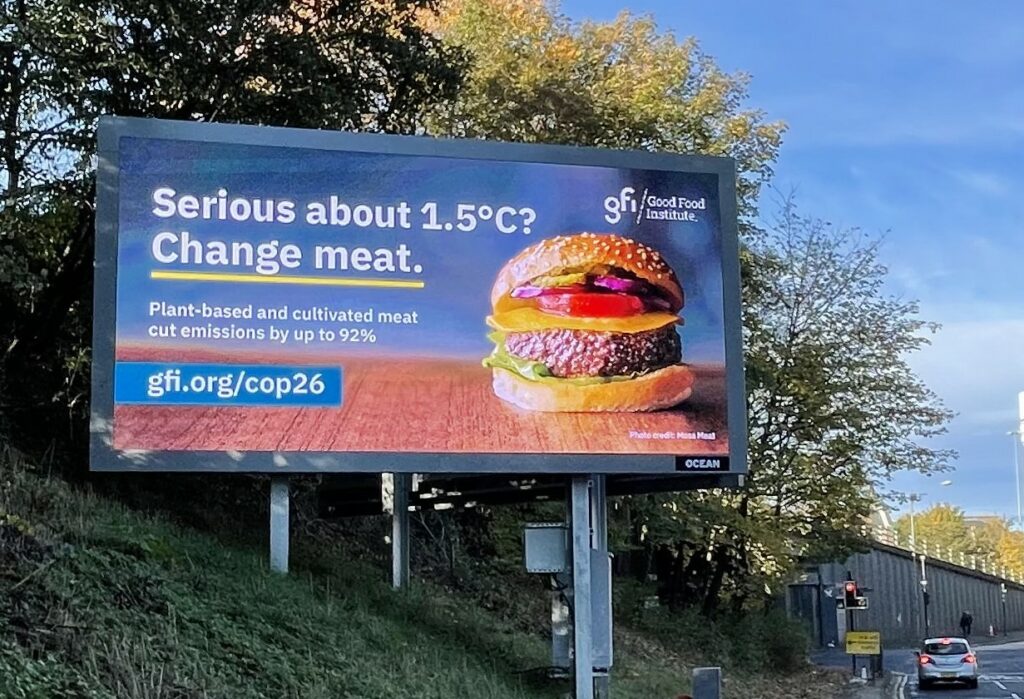Food was absent from the COP26 agenda. It must be central to COP27
17 November 2021
There is one sector that was completely absent from high level discussions, despite causing 20% of global emissions: animal agriculture.

After two weeks of negotiations, COP26 has ended in what many have described as failure.
People around the world are rightly disappointed that the deal didn’t go far enough on phasing out fossil fuels or supporting countries facing the most devastating impacts of climate breakdown. But there is one sector that was completely absent from high level discussions, despite causing 20% of global emissions: animal agriculture.
The summit saw promises to cut methane 30% by 2030 – but no mention of reducing our reliance on animal farming. This is a truly remarkable oversight, since 32% of methane emissions are caused by ruminants such as cows and sheep, and their manure.
World leaders promised to end deforestation by 2030, but failed to mention that 60% of it is caused by the production of animal feed (mostly for chickens and pigs), and grazing beef cattle.
One event addressing the contribution of animal agriculture to methane emissions was even cancelled because the subject was “too controversial”.
The Good Food Institute Europe and our international affiliates were on the ground at COP26, meeting with around 50 representatives of governments, NGOs, and industry to raise awareness about the importance of food and agriculture, and the potential of sustainable proteins to help tackle the climate crisis.
We hosted an event in Glasgow alongside the Atlantic Council, ClimateWorks Foundation and Climate Advisers. The discussion, moderated by the World Economic Forum’s Lisa Sweet, brought together policymakers, business leaders, and NGO stakeholders to align on concrete, collaborative strategies for these sectors to meet the global protein challenge.
And we posted billboards across the city to drive home our message that changing meat production is crucial for meeting climate targets.
Our biggest takeaway? Governments don’t want to tell people what to eat. And if they don’t want to tell people what to eat, they must invest in plant-based and cultivated meat – which deliver the flavour and experience of meat, with up to 92% less emissions and 95% less land.
It’s time for the sustainable protein ‘solar revolution’
The Global Innovation Needs Assessment (GINA) study launched at the start of COP26 demonstrated the enormous potential of this approach.
The report, funded by the UK Foreign, Commonwealth and Development Office and ClimateWorks Foundation, found that diversifying our protein supply to include meat made from plants and cultivated from cells could be almost as beneficial as investing in solar power.
This is incredible, when you consider the central role that solar power plays in tackling climate change.
Renewable energy sources, such as solar power, have undergone a revolution over the last decade. In the UK, for example, they generated 40% of the country’s electricity last year – up from just 10% in 2010.
This transformation has only been made possible thanks to the billions governments have invested in research and development – which have helped cut the cost of solar photovoltaics by more than 85% between 2010 and 2020.
With global demand for meat rising and little appetite for measures such as meat taxes, governments must urgently make similar investments in sustainable proteins. With public investment to improve taste and texture, bring prices down and increase availability, governments can make the sustainable choice the default.
The GINA report found that diversifying our protein supply in this way has the greatest potential of any of the land use innovations examined, in terms of reducing emissions over the next 30 years.
With $10 billion of investment from governments each year, foods such as plant-based and cultivated meat could cut global emissions by the equivalent of five gigatonnes of CO2 every year by 2050. To realise their full benefits, the GINA recommends $4.4 billion each year goes towards research and development, and $5.7 billion per year goes into commercialisation of sustainable protein options.
This investment could ultimately add $1 trillion to the global economy, create almost 10 million jobs and free up 640 million hectares of agricultural land – an area bigger than the Amazon rainforest.
Scaling up these sectors would create the space needed for planet-scale restoration of forests and other ecosystems, and incentivise more sustainable, regenerative, and agroecological farming practices, too. By combining these approaches, governments can create green economies that value healthy lands and waters, and enable farmers to enjoy livelihoods creating nature-rich, carbon sequestering landscapes – all while satisfying the world’s growing demand for meat.
Some governments may now be starting to wake up to the benefits of sustainable proteins, with the UK, Denmark, the EU and the United States all making investments in recent months. But it’s a fraction of what’s needed if world leaders are to keep their promise of limiting global temperature rises to 1.5°C.
The science is clear on this. As research from the University of Oxford found, it’s impossible to achieve the aims of the Paris Agreement without a shift away from industrial animal agriculture.
Now is the time for sustainable proteins to experience their own solar revolution. With world leaders having promised to revise their plans next year, there is a very real opportunity to make progress on food system emissions.
GFI Europe’s policy team will be pushing plant-based and cultivated meat onto the agenda for COP27, starting now.
Conventional animal agriculture causes 21% of global emissions. It must make up 21% of the discussions at next year’s summit in Sharm El Sheikh.

